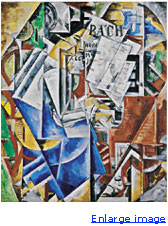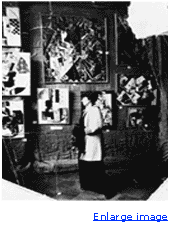
|
 |
 |

|







Order the catalogue |
 |
  With Popova, Udaltsova attended the
Acádemie de la Palette in Paris, quickly
assimilating the principles of Cubism from Henri Le
Fauconnier and Jean Metzinger. That the two apprentices
responded similarly to their lessons is clear from a
comparison of Udaltsova's Composition and Popova's
Composition with Figures, both 1913, which, with their
faceting, foreshortening, and ecomony of color, are precise
and rigorous exercises in the Cubist syntax. Udaltsova's
many renderings of guitars and restaurants are also
gestures to this primary passion. Cubism remained paramount
for Udaltsova and even though she studied the constructive
art of Vladimir Tatlin and recognized the contributions of
Kazimir Malevich, she gave comparatively scant attention to
the possibilities of abstract painting. This might explain
Udaltsova's allegiance to the Jack of Diamonds group (she
made her debut at its 1914 exhibition) which, throughout
the 1910s, emphasized the importance of Paul Cézanne
and Pablo Picasso. With Popova, Udaltsova attended the
Acádemie de la Palette in Paris, quickly
assimilating the principles of Cubism from Henri Le
Fauconnier and Jean Metzinger. That the two apprentices
responded similarly to their lessons is clear from a
comparison of Udaltsova's Composition and Popova's
Composition with Figures, both 1913, which, with their
faceting, foreshortening, and ecomony of color, are precise
and rigorous exercises in the Cubist syntax. Udaltsova's
many renderings of guitars and restaurants are also
gestures to this primary passion. Cubism remained paramount
for Udaltsova and even though she studied the constructive
art of Vladimir Tatlin and recognized the contributions of
Kazimir Malevich, she gave comparatively scant attention to
the possibilities of abstract painting. This might explain
Udaltsova's allegiance to the Jack of Diamonds group (she
made her debut at its 1914 exhibition) which, throughout
the 1910s, emphasized the importance of Paul Cézanne
and Pablo Picasso.
|
 |
 |
  Udaltsova remained loyal to the primacy of
studio painting, resisting the pressures–especially in
the wake of the October Revolution–to adjust the fine
arts to the applied or utilitarian. While she did make
Suprematist designs for textiles and taught textile design
at Vkhutemas and the Textile Institute in Moscow, she
continued to concentrate on Cubist compositions–and it
was these that attracted attention at the First Russian Art
Exhibition in Berlin in 1922. Udaltsova remained loyal to the primacy of
studio painting, resisting the pressures–especially in
the wake of the October Revolution–to adjust the fine
arts to the applied or utilitarian. While she did make
Suprematist designs for textiles and taught textile design
at Vkhutemas and the Textile Institute in Moscow, she
continued to concentrate on Cubist compositions–and it
was these that attracted attention at the First Russian Art
Exhibition in Berlin in 1922.
|

Top: At the Piano, 1915. Oil on canvas, 107 x 89
cm. Yale University Art Gallery, Gift of Collection
Société Anonyme. © Estate of Nadezhda
Udaltsova/Licensed by VAGA, New York, N.Y.
|
Bottom: Alexandra Exter in front of Udaltsova's paintings
at the exhibition The Store, Moscow, 1916
|











